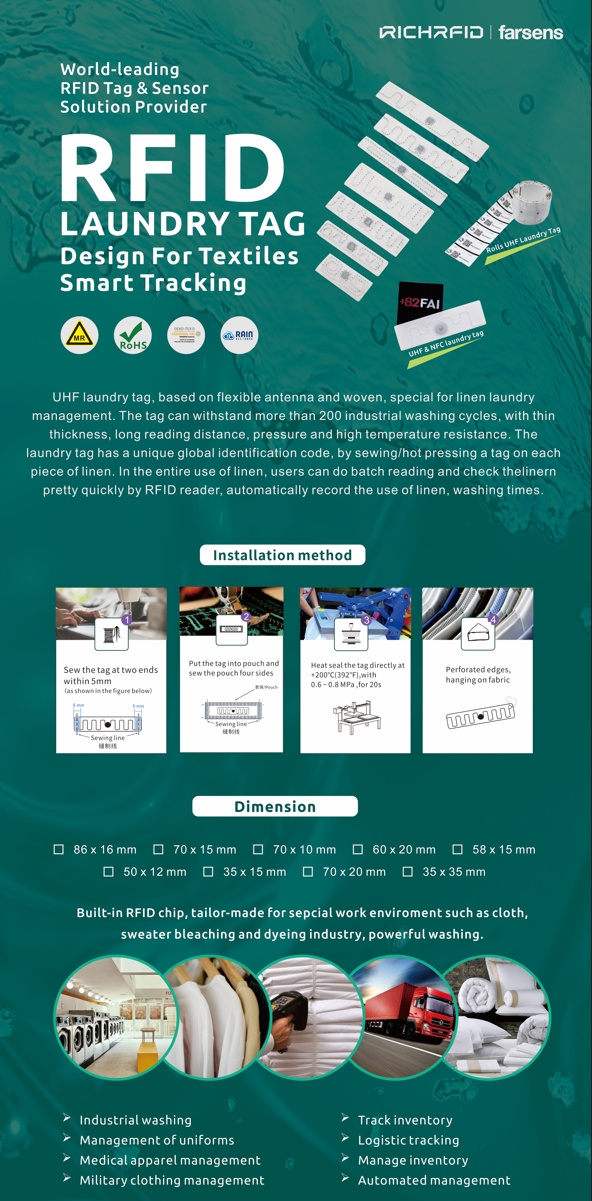
Revolutionizing Laundry Management: The Role of RFID Technology
The laundry industry, historically reliant on manual processes, has undergone a transformative shift with the adoption of Radio-Frequency Identification (RFID) technology. RFID’s ability to track, manage, and optimize laundry operations has made it indispensable in sectors such as healthcare, hospitality, and industrial laundries. This article explores the management processes, benefits, and advantages of RFID in laundry operations, highlighting its role in driving efficiency, cost savings, and sustainability.
RFID implementation begins with embedding durable RFID tags into linens, uniforms, or garments. These tags, designed to withstand high temperatures, moisture, and mechanical stress during washing, store unique identifiers linked to item details (e.g., type, owner, maintenance history).
Collection: RFID readers at drop-off points automatically scan tagged items, logging them into the system and reducing manual data entry.
Sorting: Conveyor belts equipped with RFID scanners categorize items by type, customer, or destination, minimizing human error and accelerating turnaround times.
RFID tags enable real-time tracking of laundry batches. Sensors verify wash/dry cycles, ensuring compliance with hygiene standards and preventing damage from incorrect settings.
Check-Out: RFID kiosks or handheld readers scan items during distribution, updating inventory records.
Check-In: Automated systems reconcile returned items, flagging discrepancies (e.g., missing linens) for resolution.
RFID provides real-time visibility into stock levels, locations, and usage patterns. Alerts notify managers of low stock, pilferage, or items nearing end-of-life, enabling proactive replenishment.
Data from RFID systems helps optimize machine maintenance schedules and washing protocols. Analytics tools identify trends, such as peak demand periods or underutilized assets, to refine operational workflows.
Enhanced Efficiency
Reduces manual sorting and data entry by up to 80%, accelerating throughput.
Enables batch processing of hundreds of items simultaneously.
Improved Accuracy
Near-100% inventory accuracy minimizes losses from misplacement or theft.
Ensures correct handling of specialized items (e.g., antimicrobial linens).
Cost Savings
Lowers labor costs and reduces replacement expenses by extending garment lifespan.
Cuts water, energy, and detergent use through optimized wash cycles.
Customer Satisfaction
Faster turnaround times and transparent tracking improve service quality.
Reduces errors in order fulfillment (e.g., delivering wrong uniforms).
Scalability
RFID systems adapt seamlessly to operations of all sizes, from small hotels to multinational industrial laundries.
Sustainability
Extends textile lifecycles through careful monitoring.
Supports ESG goals by reducing water and energy consumption.
Data-Driven Decision-Making
Insights into usage patterns and asset performance inform strategic planning, such as inventory purchases or pricing models.
Regulatory Compliance
Automated logs ensure adherence to hygiene standards (e.g., healthcare linens) and simplify audit processes.
Loss Prevention
Tracks high-value items (e.g., hotel towels or hospital scrubs), deterring theft and reducing shrinkage by 20–30%.
RFID technology has redefined laundry management by replacing error-prone manual processes with automated, data-driven solutions. Its ability to enhance efficiency, reduce costs, and support sustainability makes it a critical investment for modern laundries. As industries prioritize operational excellence and resource conservation, RFID stands out as a cornerstone of innovation, offering both immediate returns and long-term strategic value. Future advancements, such as integration with IoT and AI, promise to further elevate its impact, solidifying RFID’s role as a transformative force in the laundry sector.

